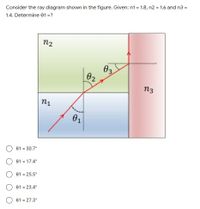Question
thumb_up100%

Transcribed Image Text:Consider the ray diagram shown in the figure. Given: \( n_1 = 1.8 \), \( n_2 = 1.6 \), and \( n_3 = 1.4 \). Determine \( \theta_1 \).
**Diagram Explanation:**
- The diagram consists of three layers, each representing a medium with different refractive indices.
- The bottom layer represents medium 1 with refractive index \( n_1 \) (1.8), and is colored in blue.
- The middle layer represents medium 2 with refractive index \( n_2 \) (1.6), and is colored in green.
- The top layer represents medium 3 with refractive index \( n_3 \) (1.4), and is colored in red.
- A ray of light moves from medium 1 to medium 2, and then into medium 3.
- The angles of incidence and refraction at each boundary are labeled as \( \theta_1 \), \( \theta_2 \), and \( \theta_3 \) respectively.
- The ray of light bends at each boundary according to Snell's Law.
**Question:**
Determine the angle \( \theta_1 \) from the options provided below:
1. \( \theta_1 = 30.7^\circ \)
2. \( \theta_1 = 17.4^\circ \)
3. \( \theta_1 = 25.5^\circ \)
4. \( \theta_1 = 23.4^\circ \)
5. \( \theta_1 = 27.3^\circ \)
Please select the correct angle \( \theta_1 \) from the given options.
Expert Solution
This question has been solved!
Explore an expertly crafted, step-by-step solution for a thorough understanding of key concepts.
Step by stepSolved in 3 steps with 1 images

Knowledge Booster
Similar questions
- A ray of light is incident on the surface of a block of diamond at an angle of 43.0° with respect to the normal (a line perpendicular to the surface at the spot where the ray hits the block). A fraction of the light is reflected and the rest refracted. What is the angle (in degrees) between the reflected and refracted rays? in degrees °arrow_forwardQuestion #1: Two plane mirrors are place perpendicular to each other. A laser hits mirror M1 30cm above the origin (0,0) as shown in the figure below. a) Find the distance from the origin where the laser will incident at mirror M2. b) How long it will take the laser to travel (in nano-second) from mirror M2 to the screen(situated 50 cm parallel to M1)? M1 25° Screen 300M M2 (0,0) is 5o cmarrow_forwardPlease refer again to Figure 2. The incident ray is coming in from water (n=1.33) rather than air. And this time, theta = 52.2 degrees, y = 31.9 cm and h = 1.13 cm. What is x now? 33.6 cm 42.0 cm 12.6 cm 50.4 cmarrow_forward
- Q₁ find JUD & C for beams 25kN/m 130KN +1.25 5 * B D 2.5 * 2.5 + EXI-Constantarrow_forwardLight traveling through medium 3 (n3 = 2.4) is incident on the interface with medium 2 (n2 = 2.0) at angle θ. If light does enter into medium 2 but no light enters into medium 1 (n1 = 1.6), what can we conclude about the range of values for θ?arrow_forward
arrow_back_ios
arrow_forward_ios